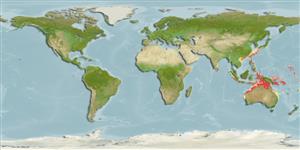>
Pleuronectiformes (Flatfishes) >
Cynoglossidae (Tonguefishes) > Cynoglossinae
Etymology: Paraplagusia: Greek, para = the side of + Greek, plagos, plagios = oblique; longirostris: longirostris from the Latin meaning 'long snout'..
Environment: milieu / climate zone / depth range / distribution range
पारिस्थितिकी
समुद्री ड़िमरसल; गहराई सीमा 12 - 86 m (Ref. 9224). Tropical
Indo-West Pacific: northern Australia and southern coast of Papua New Guinea.
आकार / वज़न / Age
Maturity: Lm ? range ? - ? cm
Max length : 27.6 cm SL पुल्लिंग / अलिंग; (Ref. 9224)
Short description
आकृति विज्ञान | मौरफोमैटरिक्स
पृष्ठीय सौफट रेज़ (सम्पूर्ण): 133-143; ऐनल सौफट रेज़: 102 - 112. Caudal vertebrae 49-55; mid-lateral line scales 115-125. Differs from all other species in the genus Paraplagusia by the non-overlapping high counts for the dorsal and anal fin rays, caudal vertebrae and mid-lateral line scales.
Life cycle and mating behavior
परिपक्व अवधि | पुनरुत्पत्ति | मछलीऔ का अंडे देना | अंडे | Fecundity | लार्वा
Chapleau, F., C.B. Renaud and P.J. Kailola, 1991. Paraplagusia longirostris, a new flatfish (Cynoglosidae) from Australia and Papua New Guinea. Jap. J. Ichthyol. 38(3):239-244. (Ref. 9224)
IUCN Red List Status (Ref. 130435)
Threat to humans
Harmless
Human uses
मात्स्यिकी: कोई रुचि बग़ैर
अधिक जानकारी
आम नामउपशब्दचपायचयपरभक्षीईकोटोकसीकोलौजीपुनरुत्पत्तिपरिपक्व अवधिमछलीऔ का अंडे देनाSpawning aggregationFecundityअंडेEgg development
Age/Sizeबाढ़Length-weightLength-lengthLength-frequenciesमौरफोमैटरिक्सआकृति विज्ञानलार्वालारवल गतिकीभर्तीबहुतायतBRUVS
संदर्भजलीयकृषिजलीयकृषि रूपरेखाखींचआनुवंशिकीElectrophoresesहैरेटिबिलटीबीमारीप्रक्रमणNutrientsMass conversion
साधन
Special reports
Download XML
इंटरनेट स्रोत
Estimates based on models
Preferred temperature (Ref.
123201): 24.8 - 28.8, mean 27.7 °C (based on 402 cells).
Phylogenetic diversity index (Ref.
82804): PD
50 = 0.5156 [Uniqueness, from 0.5 = low to 2.0 = high].
Bayesian length-weight: a=0.01514 (0.00592 - 0.03870), b=3.00 (2.77 - 3.23), in cm total length, based on LWR estimates for this (Sub)family-body shape (Ref.
93245).
Trophic level (Ref.
69278): 3.5 ±0.4 se; based on size and trophs of closest relatives
लौटाव (Ref.
120179): माध्यम, न्यूनतम जनसंख्या दुगनी होने का समय 1.4 - 4.4 वर्ष। (Preliminary K or Fecundity.).
Fishing Vulnerability (Ref.
59153): Low vulnerability (24 of 100).
